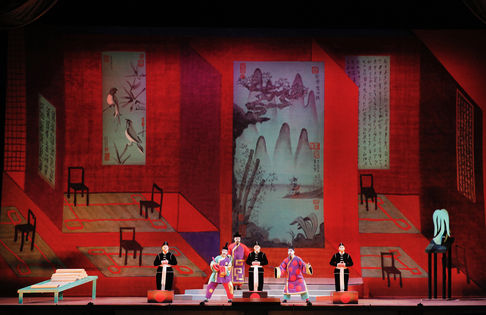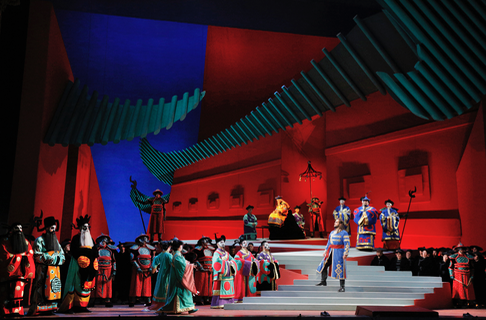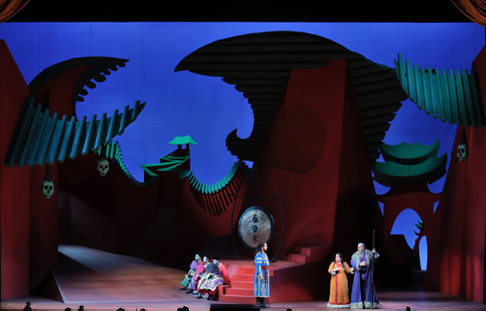The hype surrounding the Hockney retrospective just now in Paris, last year in London and soon to arrive at New York’s Met (November 27), and certainly the 2013 Hockney exhibition at SF’s De Young have kept this now 80 year-old icon of canvas painting at the center of the art world’s attention.
Thus there has been excited anticipation of this operatic addition to a Hockney retrospective. His 1992 Turandot burst just now onto the War Memorial stage like it had never before been there. And there are reasons for this perception.
There was a more intense sense of color indeed as the scenic drops had been repainted, plus (and I am surmising) there were (perhaps) more sophisticated lighting instruments in use that brought greater luminosity to color and clarity of shape. [For the record: current SFO lighting designer Gary Marder used the original 1993 lighting plot to light the scenery. Intensities were brightened from those found on a poor quality video of the 1993 production. Newer high-intensity lamps were used to light the actors.]
 Act II, scene 1. Ping, Pang, Pong, in front of Hockney drop in reverse perspective
Act II, scene 1. Ping, Pang, Pong, in front of Hockney drop in reverse perspective
A more compelling contribution for this new discovery of the Hockney production was conductor Nicola Luisotti who triggered timeless lyricism into the Puccini’s sonically massive score. As David Hockney defies space with his plays of and on perspective, conductor Luisotti made time stand still with tempos and tonalities that dwelt on fixing the specific place and amplifying the immediate emotion — in fact eternalizing the moment. It was an amazing musical feat that intensified the Hockney discovery of the huge spaces and boundless desire.
The opera Turandot is much like what Hockney discovers in his L.A. swimming pools — a magical world of vivid color and commanding shape in which not-so-covert desires dance in motionless forms. That Puccini’s Turandot is dramatically stagnant intrigued Hockney and Luisotti to create Puccini’s opera as a parable of desire extended onto a timeless flat canvas.
 Act II, scene 2. Calaf answering riddles
Act II, scene 2. Calaf answering riddles
As conducted by Luisotti last night the Hockney production proved itself a masterpiece.
Of the cast only Austrian soprano Martina Serafin rose to the level of the production. The 47 year-old diva rang the icy tones of a Turandot isolated in blind revenge until her emotions finally roared forth in unleashed verismo. She and conductor Luisotti musically and dramatically validated Franco Alfano’s controversial conclusion.
American tenor Brian Jagde has finally found his niche as the stentorian Calaf with such tones unrelentingly imposed on Turandot and the Chinese crowds and us. If initially thrilling in effect his clean tone wore as it remained unvaried. This fine, young tenor showed his stylistic limitations in the first act where middle voice strength and emotional mannering make Calaf one of the repertoire’s more challenging roles. Adler Fellow (SFO’s finishing school) Toni Marie Palmertree sang Liu quite beautifully but Liu’s innocence was replaced with the bravura of inexperience.
 Act 1. Ping, Pang, Pong, Calaf, Li˘ and Timur
Act 1. Ping, Pang, Pong, Calaf, Li˘ and Timur
The pathos of Calaf’s father Timur, sung by bass Raymond Aceto, somehow got lost in the melÈe. Korean baritone Joo Won Kang was a lovely sounding if small voiced Ping, Korean tenor Julius Ahn as Pang added energy to the trio of counselors, and tenor Joel Sorensen as Pong capped the group with infectious gusto. Baritone Robert Brubaker delivered, gratefully, the Emperor Altoum as a dignified, fine voiced father of Turandot.
The huge chorus and the principals were expertly and very beautifully posed and moved about by American regional stage director Garnett Bruce who always respected the flat surface of the stage canvas. He amusingly employed six, mostly-naked senior citizen eunuchs to execute the Prince of Persia and later to remove the dead Liu.
Michael Milenski
Cast and production information:
Turandot: Martina Serafin; Calaf: Brian Jagde; Li˘: Toni Marie Palmertree; Timur: Raymond Aceto; Ping: Joo Won Kang; Pang: Julius Ahn; Pong: Joel Sorensen; A Mandarin: Brad Walker; Emperor Altoum: Robert Brubaker. San Francisco Opera Chorus and Orchestra. Conductor: Nicola Luisotti; Production and Design: David Hockney; Director: Garnett Bruce; Costume Designer: Ian Falconer; Original Lighting Designer: Thomas J. Munn; Lighting Designer: Gary Marder; Choreographer: Lawrence Pech. War Memorial Opera House, San Francisco, California, September 12, 2017.
image=http://www.operatoday.com/Turandot17_SF1.png
product=yes
product_title=Turandot at San Francisco Opera
product_by=A review by Michael Milenski
product_id=Above: Martina Serafin as Turandot [All photos copyright Cory Weaver courtesy of San Francisco Operar]